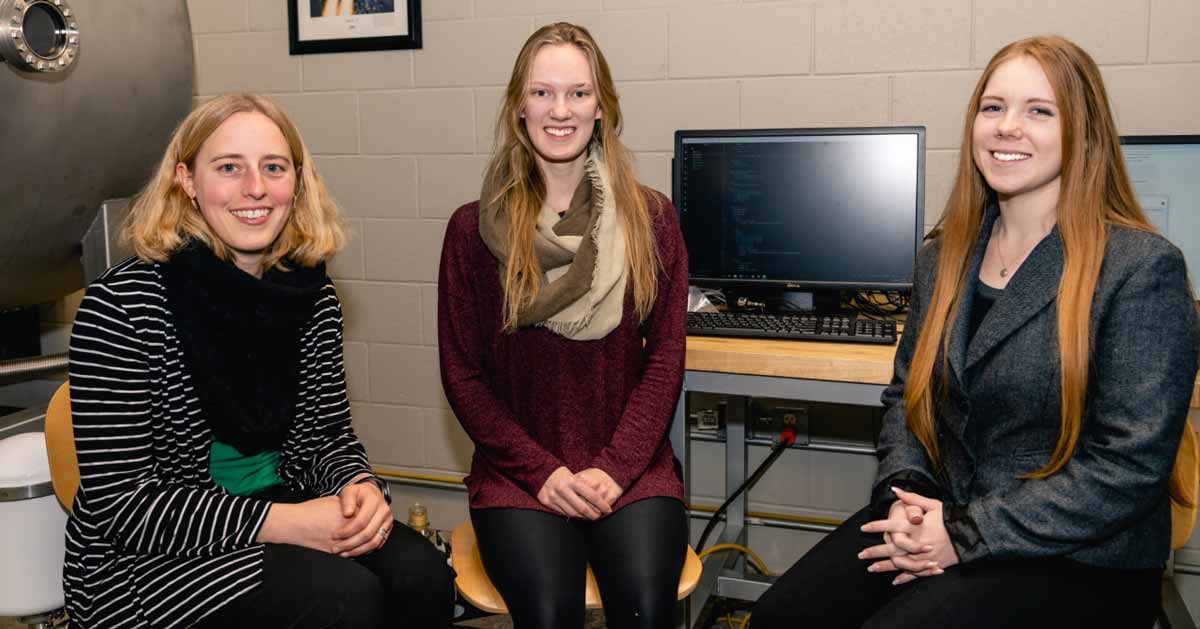Two Embry-Riddle Undergraduate Students Supporting Interplanetary Research

PRESCOTT, Ariz. – Two undergraduate students of Aerospace Engineering Assistant Professor Kaela Martin, at Embry-Riddle Aeronautical University’s Prescott, Arizona Campus, have published research findings that will help interplanetary space mission designers more easily locate the relative positions of planets, moons and small bodies in the solar system at specific times in order to calculate optimum spacecraft trajectories.
“We find ourselves among graduate students and Ph.Ds. who are genuinely interested in our work,” said Julia Mihaylov, who with classmate Renee Spear, are the co-authors on the published papers and conference presentations about the research.
Since 2016, Martin has worked during summers with the NASA Jet Propulsion Laboratory through JPL’s faculty fellowship program. Her work at JPL has presented challenging and rewarding opportunities for her College of Engineering students, including Spear and Mihaylov. Their American Institute of Aeronautics and Astronautics conference paper, entitled “Julia Language Ephemeris and Physical Constants Reader for Solar System Bodies,” was co-authored by Martin and JPL Mission Formulation Engineer Damon Landau.
Julia Language is a high-level dynamic programming language used in computational science. Martin developed the ephemeris reader to translate the mathematic calculations of Julia Language into formulas for spacecraft navigation, to help show the precise positions of naturally occurring astronomical objects and artificial satellites at any given time.
“Working on the project with Dr. Martin has been an incredible opportunity,” said Spear. “Dr. Martin is always willing to answer questions and provide assistance, explore concepts with her research students, and help point them in the right direction.”
Martin — who worked on finding trajectory options for NASA’s proposed astrobiology mission to Europa, one of Jupiter’s larger moons — wasn’t always interested in aerospace engineering. Her involvement came about in stages.
As a child at her family’s cabin in northern Minnesota, Martin would gaze at the stars, referring to a map of the constellations her father had been given when he bought a car with a moon roof. She didn’t really start considering engineering until she started college, planning to major in mathematics and take some courses in engineering.
“It was very intimidating to sit next to people in aerospace engineering classes who knew every large commercial airliner in production, and all I had going for me was that I liked to look at the stars,” she said.
Even as the field slowly drew Martin in, she always enjoyed teaching. In high school and college, she tutored other students in math. In graduate school, she taught a class on her own.
“I love teaching and mentoring. It’s a magical moment watching a student get it for the first time,” Martin said, adding that her “main goal as an educator is to teach others how to learn.”
“If you look at technology from twenty years ago compared to today,” she said, “you'll see vast differences in what skills were needed to be successful in a job. Learning doesn’t stop when you graduate.”
The success that Spear and Mihaylov have achieved with their research represents valuable skills they have acquired, said Martin.
“Julia and Renee have gained valuable experience writing papers and learning how to present the material to different audiences,” Martin said. “They have also learned a skill, coding in Julia, that they would have otherwise never learned in school.”
Meanwhile, the two aerospace engineering undergraduates have been able to network with professionals and fellow researchers at JPL and at conferences.
“The work is great hands-on industry experience,” said Mihaylov. “I have met and connected with countless industry professionals and scholars who are able to give their outlook and guidance on education and careers in engineering.”
— By Michaela Jarvis
